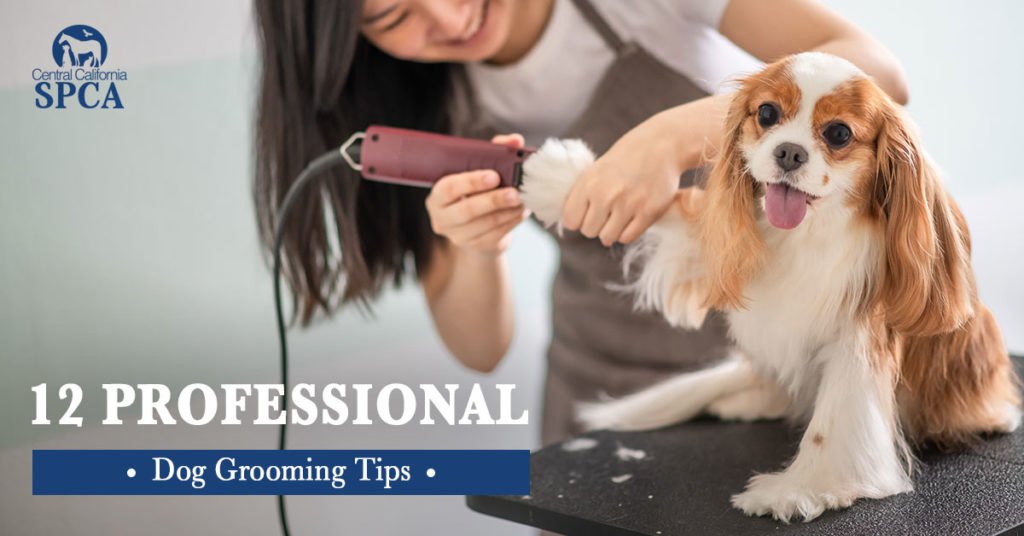Every dog requires some grooming, whether it’s as simple as nail trimming or as extensive as a poodle’s pompadour with bows. But not everyone has access to or can afford a monthly trip to the local dog “salon,” so we’ve put together some dog grooming tips and tricks from professionals around the country.
These professional dog grooming tips should make your life easier, make your dog look like a million bucks, and help keep your budget intact.
12 Professional Dog Grooming Tips
While you might not achieve the quality of a Westminster Kennel Club champion, you can learn more about the process and keep your dog clean as a whistle, with a pretty coat for all to admire.
1. Routine: Develop a routine that works for both you and your dog. Same shampoo, same bathing spot, same steps every time. This makes it easier on you and they’ll know what to expect and be less anxious. Make sure to clean every part of their body, including the belly and face, and make sure that you rinse thoroughly. You don’t want any shampoo residue left on the skin or in the coat.
2. Choose the Shampoo: Just like for humans, there are a variety of canine shampoos. What you choose will be based on your needs:
- To control fleas, you’ll use a flea shampoo.
- For dry skin, try an oatmeal-based shampoo.
- For skin irritations, dandruff, or hot spots, a medicated shampoo with coal tar and hydrocortisone should help.
- Puppies need special shampoo that won’t make them tear up. They are extra wiggly and there’s no avoiding getting suds in the eyes, so make it more comfortable with a tearless puppy shampoo.
- To brighten up a coat, buy a whitening shampoo.
- Sensitive skin will need a hypoallergenic shampoo.
In general, oatmeal-based shampoos are usually the best basic option. Additionally, conditioners can be used if your dog has dry or sensitive skin, and dry or brittle hair. It also can help reduce matting.
3. Deshedding/Dematting: Take a comb or brush and work through the coat as you’re rinsing to rid your dog of excess loose hair and to detangle any mats that they’ve developed. You’ll find it easier you do this during the bathing routine, rather than when you’re trying to dry them.
4. Grooming Equipment: If you plan on doing all the grooming yourself, one highly recommended professional dog grooming tip is not to skimp on the tools you’ll need (brushes, scissors, trimmers). Not only will they last longer, but they will work better than their cheaper cousins. Make sure that you clean your equipment after every use and lubricate and sharpen as necessary to prolong the life of the tool.
5. Organize Your Equipment: Having everything in one place — shampoo, combs, brushes, scissors, trimmers, etc. — will keep the process moving along. There’s nothing like an anxious dog making its escape while you search for the right pair of scissors.
6. Get a Helping Hand: Many dogs will not sit still for drying and trimming, so you might need a little help. One dog-grooming trick is to use a Groomers Helper device to stabilize your dog and keep him from struggling, biting or spinning. It will actually make your job go by all that much faster, a relief for the dog as well. If equipment isn’t in your budget, ask a family member or friend your pet is comfortable with to lend a helping hand.
7. Dry Before Grooming: Make sure that you thoroughly dry your dog before grooming. Partially dried coats will tend to curl more, making it difficult to get an even trim. This way you can do one pass with the clippers, rather than two.
8. Clippers 101: If you’ll be trimming your dog’s coat, you will need a pair of clippers and one or more blades. Blades are numbered differently than human clipper blades, where 1 is the shortest. To keep your dog’s coat longer, use a #5/8, #3, or #4. For a shorter cut, go with #5, #7, #9, or #10. Make sure that your blade is a finish-cut or FC version. The teeth are spaced a bit farther apart and the blades aren’t as sharp as a skip-tooth blade, which should be reserved for pro groomers. Also, for armpits, around eyes and in the sanitary area, use only a #10 blade.
9. Grooming Made Easy: Always go with the lay of the hair when trimming. Keep the tip of your blade down against the skin, holding the back at an angle. Then pull the skin taut as you move your trimmer along the coat (to avoid cutting the skin).
10. Trimming Paws: If you need to trim between the pads or around the edge of the paws, one of the simplest dog grooming tips is to move your dog to the edge of the work surface, so it makes it easier for you to get to.
11. Right Tool for Trimming Nails: There are a variety of clippers available, from electric dremel-style tools to scissor and guillotine styles. There is no need to invest in an electric dremel nail grinder. It is more expensive than the other styles and the noise can be off-putting to your dog, who probably isn’t fond of the procedure to begin with.
12. How to Trim the Nails: Start with the back paws, as they tend to be less sensitive. Hold the paw firmly in your hand. Cut the end off the nail, below the quick, at a 45-degree angle. You can choose to take several small cuts or one larger cut, but be very careful not to cut too deep. (Some clippers come with a guide that only allows you to cut a small amount at a time.) You can trim the nail up until you see a small black dot in the center, surrounded by white.
Note: Keep styptic powder, which comes in a special holder, nearby in case you cut the nail too short. The holder makes it easy to grab and dip the nail into for stem any bleeding.
Bonus Dog Grooming Tip
If you want to get real fancy and paint the toenails on your dog, slip the end of a leg of pantyhose over the dog’s paw, poking the nails through the nylon. This will keep the hair on the paws from sticking to the lovely pink polish you’ve chosen.
Happy Grooming!
Website source: https://www.ccspca.com/blog-spca/professional-dog-grooming-tips/

